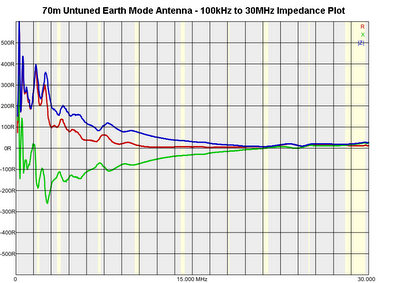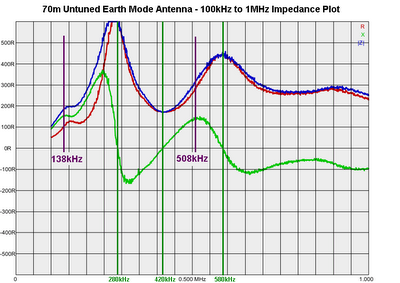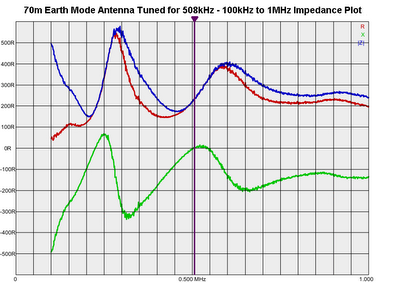Earth Mode Antenna Measurements - Part 1
I was curious to see if there was any correlation with measurements made by John - G0AKN (SK) some years ago in the UK.
The antenna configuration measured is the temporary 70m earth-mode setup where a connection is made between a set of three earth rods at the bottom of the block and a single station earth rod near the front. The connections are temporary just consisting of alligator-teethed jumper wires attached to various points.
During 'tuned' measurements a switched capacitor bank was used for two spot frequencies of 138kHz and 500kHz. During 'untuned' measurements this capacitor bank was bypassed. The capacitance needed for zero reactance (resonance ?) was found to be 8.1nF and 2.3nF for 138kHz and 500kHz respectively. I use 'tuned' and 'untuned' in single quotes as I am not sure whether those terms are strictly correct - it could just as easily be called 'power-factor correction'...
'Untuned' Impedance Measurements
First a full frequency scan (100kHz to 30MHz) of the 'untuned' 70m earth-mode antenna was done as shown below... (click graphic to see a larger picture). The scan was captured by using the AntScope PC software supplied with the AA-30 which allows computer control and acquisition of measurements.
The key to this graph (and all the following graphs) is Red = resistance, Green = reactance, Blue = impedance.
The yellow backgrounded sections are the normal amateur band allocations. The impedance starts from a low value at low frequencies, goes through a number of swings as frequency is increased and settles down to a low value again by about 10MHz. I would speculate that there would be little utility of this configuration above 7MHz - but as I have little idea of the radio properties of the earth-mode configuration - this is, I repeat, speculation on my part...
Most of the 'action' appears to be at the lower frequencies. My particular interests lie in the LF and lower MF bands (specifically 138kHz and 508kHz). The 136kHz band is available to all Advanced Licence holders here in VK and I have an authorisation for operation on 505kHz to 515kHz until October 2012 (AX2NMR). Accordingly I narrowed the scan to 100kHz to 1MHz and ran again with 1000 measurement points as shown below... ( again - click graphic to see larger picture)
The above graphic has been marked-up with a number of interesting features. Points marked are the two spot frequencies of interest - 138kHz and 508kHz, and also frequencies where the reactive component (green curve) passes through zero value ohms at 280kHz, 420kHz and 580kHz.
Of note from this graph is that, at this QTH and with this configuration (70m spacing), the reactance is inductive below 280kHz (at least down to 100kHz), capacitive between 280kHz and 420kHz, returning to inductive between 420kHz and 580kHz, and finally settling to be capacitive for all frequencies above 580kHz. The exception is a brief excursion back to inductive around 1.5MHz as shown on the full 100kHz to 30MHz scan above.
From this result it can be speculated that this is the reason that for a given frequency, different probe spacings and/or different ground geology the impedance may be appear to be inductive or capacitive. Also, if the configuration and frequency of operation was such that the configuration was operating near a zero reactance point, say near 280kHz, 420kHz or 580kHz for this configuration, weather effects on ground characteristics could mean that one day the impedance is slightly inductive, the next day it might be slightly capacitive.
Note: - as an aside to these results the variation in impedance seen while sweeping over a wide frequency range lends support to a suspicion I have long held about the wisdom of extrapolating measurement results of earthing systems obtained using 50Hz excitation to a general case. It appears, from these measurements, that a low resistance at 50Hz may not necessarily be translated, in all configurations, to higher frequencies. There is plenty of practical experience where paralleling up individual "good" earth connections has seen a rise in earth resistance. These measurements here may give a clue that perhaps the behaviour of earth systems at different frequencies is not quite as well understand as might be believed...
'Tuned' Impedance Measurements
As mentioned before I am slightly uncomfortable with talking about 'tuning' the earth-mode antenna as I am unsure that this is what is happening in the usual sense. It is more an impedance-reduction method or, if you like, a current maximising method. But I will use 'tuning' as a convenient handle.
At 138kHz the impedance appears inductive (+j150) which corresponds to the reactance at 138kHz of a 173uH inductance. This should be 'tuned-out' by placing a -j150 reactance in series (about 8nF capacitance). Inserting that capacitance does indeed reduce the reactive component to near zero at 138kHz. The resistive component is little affected as the capacitor ESR is small compared to the 100 ohms antenna resistance.
The impedance plot spanning from 100kHz to 1MHz was run again as shown below...
As can be seen the shape of the curves is largely unaltered. The addition of series capacitive reactance (-jXc) has pushed the green reactance curve down, resulting in the value of reactance at 138kHz being reduced from +j150 to zero.
At 508kHz the impedance also appears inductive (+j140) which corresponds to the reactance at 508kHz of about 40uH inductance. This should be 'tuned-out' by placing a -j140 reactance in series (about 2.2nF capacitance). Once again, inserting that capacitance does indeed reduce the reactive component to near zero at 508kHz.
The impedance plot for the 508kHz 'tuned' antenna spanning from 100kHz to 1MHz was run again as shown below...
Once again it can be seen that the shape of the curves is largely unaltered. The addition of a higher series capacitive reactance (-jXc) has pushed the green reactance curve even further down, resulting in the value of reactance at 508kHz being reduced from +j140 to zero, but also slightly altering the total impedance curve (blue), especially at the lowest end as would be expected.



